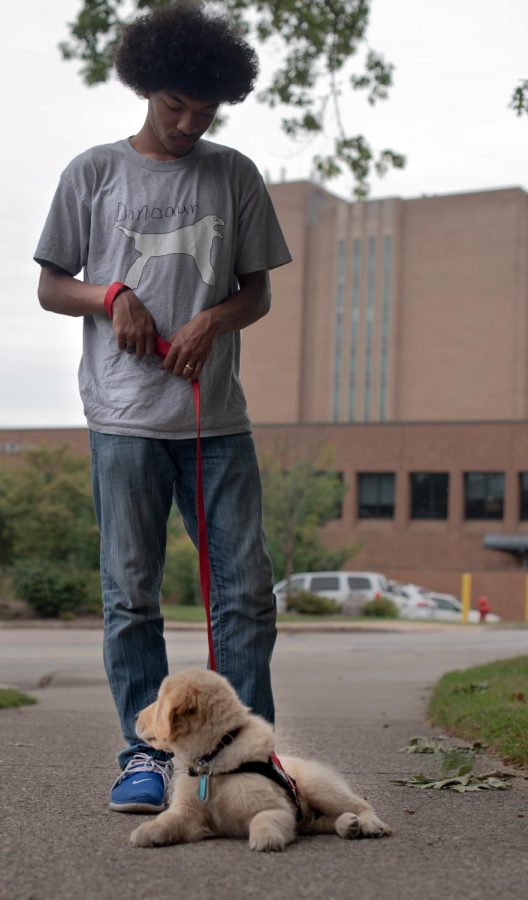Students train man’s best friend
September 25, 2019
TréFle may seem like the average six-month-old Golden Retriever in a lot of ways. He likes to run, play and cuddle with his owner at night. But when he walks out the door, he has a very important job to do.
Tré is being trained as a service dog through the 4 Paws for Ability university program and might be matched with a child or veteran in need when he eventually receives his service dog certification.
University Puppy Raiser Program Coordinator Lynn Agee said the nonprofit started to work with universities in 2007, after realizing the advantages college students offered in terms of socializing the dogs.
“The main focus for any of our puppy raisers is to socialize the dogs. To basically take them anywhere and everywhere so they can become exposed to many different sights, things and sounds,” Agee said. “We realized how beneficial it was for the dogs to grow up with students who could take them everywhere with them.”
Emily Steinbrenner, a sophomore photography major and Tré’s student trainer, said university students are expected to teach the dogs basic commands like sit, stay and stand.
“You take a dog in, you raise them, you get attached which sucks, but you teach them basic commands … and you have to make them walk right next to your side,” Steinbrenner said.
Agee said the amount of time the dog spends with the student trainer varies due to the student’s time commitment.
“Every puppy raiser is different in how long they choose to be a part of the program,” Agee said. “Some puppy raisers only want to have the dogs on the weekends, some want to have the dogs from a young age up until they are needed back at 4 Paws for advanced training.”
After leaving their student trainer, there are several paths 4 Paws dogs can follow.
“They go on a couple different paths,” Steinbrenner said. “There’s a breeder path, if they pass their evaluation they go on advanced training to become a service dog, … or they become a ‘fabulous flunky’ and they’ll just become a regular house pet if they fail (the evaluation).”
Agee said, dogs either begin training to become a match for applicants who are waiting for a service dog, or go up for adoption if they are considered “unfit” as a service animal.
The organization’s 2017 annual report said, “We have a 98 percent success rate in placements: we have a 90 percent success rate with the first dog placed in the home and an overall success rate of 98 percent.”
Students can volunteer to be a dog trainer or a dog sitter and watch over the dog when its primary trainer is unable to do so. Volunteer applications can be found on the 4 Paws website.
Agee said the training process for student volunteers begins after the application is approved.
“There is an online orientation that must be completed before attending an on-site orientation,” Agee said. “The entire orientation process it meant to prepare puppy raisers and puppy sitters for handling 4 Paws Dogs and goes over all of 4 Paws for Ability’s policies and procedures. Puppy raisers are required to attend monthly obedience classes and sitters are required to attend them once every three months.”
4 Paws currently works with 25 universities and has around 2,000 student volunteers involved in the program.
Steinbrenner said she would encourage Kent State students to volunteer.
“It’s something new to experience. College is all about trying new things and experiencing new types of experiences… it’s just something different.” Steinbrenner said. “Just knowing that one day the dog that you raise is going to possibly help a child in need … it’s a nice feeling.”
Contact Zaria Johnson at [email protected].

























